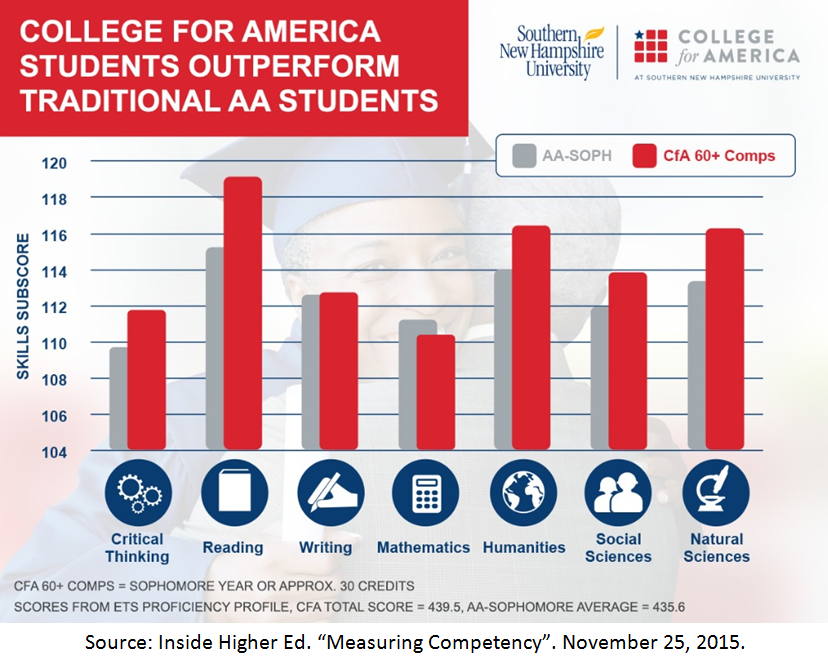
Khan Academy Arrives in Latin America
The Khan Academy, challenges the traditional teaching model with its instructional online videos and learn-as-you-go problem sets.
This post is also available in: Spanish
As part of our skills development project, and following our policy brief on online competency-based education, Federico Sucre (FS), Program Associate for Education at the Inter-American Dialogue, interviewed Dr. Heidi Wilkes (HW), Senior Director of Curriculum and Assessment Development at College for America.
FS: What is College for America and what motivated its creation? What issue are you trying to tackle?
HW: College for America (CfA) at Southern New Hampshire University (SNHU) was created to address the need in the U.S. for flexible, accessible, accredited, affordable and workforce relevant college degrees. At CfA, students pursue traditional college degrees and credentials in a nontraditional way. CfA graduates receive their diplomas from SNHU, and their Certificates, Associate of Arts, and Bachelor of Arts degrees are low-cost, self-paced, online and 100% competency-based.
CFA currently has about 3,000 students enrolled in our rapidly growing programs, most of whom are working adults. Our model is subscription-based. Students pay one flat fee, currently 1,250 U.S. dollars, for six-months. During that six-month period students have flexibility in determining their own pace and, after mastering a set minimum, can work towards mastery of as many competencies as they want, or as time allows.
FS: How is the competency-based education (CBE) model different from the traditional university model?
HW: The typical model in the U.S. is based on “seat time” – credit hours. In that model, students have a limited amount of time to pass a course; if they need longer or could master the material sooner, they are out of luck. In contrast, our competency-based education (CBE) model focuses on mastery, rather than time. Students do not enroll in and attend courses. Students do not take exams that measure content knowledge alone. Instead, they are required to complete authentic and workplace-relevant projects to demonstrate mastery of competencies. They also have multiple opportunities to reach mastery. The bottom line is that students show what they can do and are assessed on the work they produce, not how long they were in class.
FS: How do you design and implement the competency-based model? Who designs the curriculum and who reviews the students’ mastery of competencies?
HW: CFA employs a team of expert curriculum and assessment developers who work with academically qualified Subject Matter Experts and faculty to design authentic projects that allow students to demonstrate the competencies in the approved curriculum. Projects simulate realistic workplace scenarios that engage students. The curriculum is delivered through a custom and proprietary Learning Management System built on the Salesforce platform.
Academically qualified Reviewers assess mastery of competencies using detailed rubrics (scoring guides) and provide feedback within 48 hours. Students receive the scored rubric along with targeted feedback about areas where the student has performed well and guidance about any areas that require improvement. There are no grades. In CFA’s CBE programs there is no getting by with a “gentleman’s C.” Competencies are either mastered or not yet mastered. Students may resubmit as many times as needed to achieve mastery.
Projects are authentic assessments presented in a workplace-relevant context. Our students appreciate this approach because their work in projects can often be implemented right away on the job. We routinely receive comments from students and Learning Coaches about the value of the projects in our CBE curriculum. For example one Coach wrote, “My student presented her You’re So Lean project for two hours today to make processes more efficient at the hospital system. After the presentation they decided to pilot her idea and she is now in charge of re-writing hospital policies!”
FS: How does CfA partner with companies and organizations to serve employees/students?
HW: We work with employer partners to offer our programs to their employees. Employers are keenly interested in competency-based programs because there is an immediate payoff when employees develop new workforce relevant skills. In addition, many employers face a shortage of skilled workers in high need areas and our programs help employers to upskill their workforces, resulting in more employees qualified to move into these jobs. Many large employers in the U.S. offer tuition assistance or reimbursement, which often covers the entire cost of attending CfA.
Students receive a traditional transcript showing SNHU course equivalencies for their work, along with a competency transcript that describes each competency the student has mastered along the way to achieving the academic credential. Competency transcripts are highly valuable to employers because the employer has detailed insight into what a student has demonstrated that he or she can do as opposed to what he or she should know.
FS: What is the system of accreditation at CfA? Is it recognized by state and federal regulators?
HW: CFA’s curricula are reviewed and approved both through Southern New Hampshire University governance and the University’s accrediting agency, New England Association of Schools and Colleges (NEASC), which currently requires a separate review and approval process for direct assessment programs. CFA is a leader in competency-based education and was, in 2013, the first institution to receive approval to offer Title IV federal financial aid under the U.S. Department of Education’s direct assessment provisions. While employers cover tuition for most CfA students, other students must rely on financial aid to cover the cost. CfA’s approval by the US Department of Education was regarded by many as a milestone event in CBE and higher education in the United States.
FS: What kind of programs do you offer at CfA?
HW: CFA offerings include a Certificate in Healthcare Management Fundamentals, an Associate of Arts degree in General Studies with a concentration in Business, an Associate of Arts degree in Healthcare Management, a Bachelor of Arts degree in Communications with concentrations in Business and Healthcare, a Bachelor of Arts degree in Healthcare Management with concentrations in Communications and Global Perspectives, and a Bachelor of Arts degree in Management with concentrations in Insurance Services, Logistics and Operations, and Public Administration.
In true CFA fashion, we worked with employers and our workforce research team to design degrees in growth areas. We are excited about our future, the future of CBE in the U.S., and continuing to provide high quality, relevant, accessible, and affordable degrees and credentials that transform the lives of our students.
FS: Have you conducted any impact evaluations? What are some indicators you use to track success?
HW: We are sometimes challenged to provide evidence of the effectiveness of our CBE programs, ironically most often by colleagues and critics in traditional higher education programs who cannot provide that same evidence about their own programs. Our programs are relatively new, but even so, we are already starting to establish benchmarks and systems to collect and provide evidence of learning.
On November 25, 2015 Inside Higher Ed published an article about our efforts. We used the ETS® Proficiency Profile assessment to measure performance of students who were at least halfway through the Associate of Arts program, having mastered at least 60 competencies. The ETS Proficiency Profile is a measurement of core skills and our students did very well compared to the comparison group of 7,815 Associate Level students at other U.S. institutions. The results in the graph below show that our students are at or above the comparison group in all areas except math, and in that area they are close.
As we grow and graduate more students we will have more data about the effectiveness of our programs and will use that data to continuously improve them.

FS: Who are your students? Can you provide some demographic characteristics?
HW: The average age of a CfA AA student is 37.2 and 76.9% of our students are female. Of students who responded to questions related to race, 49.1% identified as White, 29.7% identified as Black or African-American, 16.7% identified as Hispanic/Latino, 1.2% identified as Asian, 0.7% identified as American Indian, and 0.3% identified as Hawaiian/Pacific Islander. More than half (55.1%) reported a status of single and 60.6% reported having at least one dependent. Approximately 27.6% of CfA students have some previous college with an average of 27.1 credits earned.
The average age of a CfA BA student is 39.7 and 78.1% of our students are female. Of students who responded to questions related to race, 52.1% identified as White, 25.6% identified as Black or African-American, 11.8% identified as Hispanic/Latino, 1.6% identified as Asian, and 0.3% identified as Hawaiian/Pacific Islander. 42.5% reported a status of single and 59.5% reported having at least one dependent. Students enter into the BA program holding an associate degree or equivalent credits.
CfA students come from a variety of industries, including, but not limited to healthcare, manufacturing, insurance, government, and retail. Our employer partners include Anthem, Medtronic, Partners Healthcare, and Dell, to name a few. The thing that most of our employer partners have in common is a large frontline workforce coupled with growth opportunities for employees who gain skills and competencies and earn the degree or credential needed for the next level promotion. Students seek to learn and grow in their professional and personal lives. Employers are keenly interested in ways to help employees develop and achieve within the company. CfA programs help both students and employers reach their goals.
FS: What can policymakers learn from the online CBE model?
HW: Disruptive innovations, like the CfA CBE model and others, are attempts to create a sea change in education, largely for underserved or unserved populations of students. The traditional existing models, while entirely appropriate for some, do not work well for many students including working adults. Administrators seeking to increase access to higher education and to upskill workforces can move the needle by creating policies that support the development and funding of new innovations in education. Current policies may lead to unintended consequences such as creating barriers to educational access and discouraging innovation. Forward thinking policymakers can work toward reforming existing and outdated policies to create the right environment for transformational change to happen.
Photo Credit: Plantronicsgermany / Flickr / CC BY-ND 2.0
Lessons from Online Competency-Based Education
The Khan Academy, challenges the traditional teaching model with its instructional online videos and learn-as-you-go problem sets.
Latin America leads the world in talent shortages, and that the problem is getting worse
An analysis of global trends and their impact on education policies in Chile.

